 |
||
|
||
| ||
IntroductionToday's motherboards are often developed not only by engineers but also by designers. The latter ones do their best, especially when speaking about AOpen and Gigabyte mainboards. To arrest customers' attention the companies use not only good technical characteristics of their products but also attractive color solutions as compared with standard two-colored ones. Stylish blue boards from Gigabyte meant for the retail market will undoubtedly draw attention of buyers. AOpen has gone even further: apart from the well thought-out design of the board (including the color of the chipset's heat sink, frequently sputtered with noble metals etc.), they take care of the housing - the box. Boards in AOpen implementation are put in a plastic case, and an external cardboard box (traditionally bright) has an advantage: it has got some openings through which a user can estimate the card's design. As usual, other companies have followed the pioneers. Undoubtedly it makes no sense to pass all products through design studios since such boards become too pricy. But it is worth making a diamond of one of the most popular company's products to crown its constellation of motherboards: it strengthens the image, increases the interest to the products, and positively influences the sales volume. May be this increase won't be such dramatically high, however, it is not a momentary advertising action but a well thought-out marketing strategy ... Inside And Outside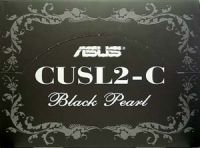  All these measures were taken by the top mainboard manufacturer - Asustek. They took their bestseller - the CUSL2-C board - and worked a bit on its design thus receiving an elite product. "A bit of work" means that coloring the PCB black and sputtering a 5-carat gold layer on the heat sink doesn't require much imagination since there is AOpen with its experience. But the design of the box and accessories (the standard complete set includes only a SmartTool screw-driver) took much more strain from the specialists. Mainboard and its "shelter" shared with "friends" (a box, a user's manual, etc.) have never looked so stylish. All the components are silvery-black, and only a gold-plated heatsink is an exception. I think they should have covered the heatsink with silver or platinum (like some AOpen boards), or have made it of silver (like a Silverado cooler of NoiseControl made of 999 hallmark silver). Apart from the stylish solution I would like to consider the stuff supplied with the board. A SmartTool screwdriver is a trifle, but it is often very useful.  And I think the psychologists have also participated in the development of this product: a customer keeping such a trinket in his mind will look for products of exactly that company which remained in his memory due to such a small advantage as a screwdriver. The complete set also includes SmartCard Reader.  In particular, you can install a SIM-card of your GSM cell phone into a full-sized card supplied with the mainboard, and with the Winbond software you can change the parameters, for example, of a PhoneBook. Usage of this card is, in fact, limited only by your imagination. Unfortunately, this device is not always present in the set. The box also contains a stylish User's Manual in English. 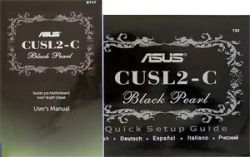 However, not the release of the CUSL2-CB board turned to be a cause of such change in the cover: analog manuals for earlier boards (for example, the A7A266) had a similar design, though the box was yellow. I suppose we will see some new (changed in design) boxes for Asustek's motherboards soon, or the company marks these two products out of the common raw. The company sometimes adds something new to the appearance of the boards' boxes, which has always testified that the developers have paid special attention to some of their products. Apart from the standard User's Manual with information on the BIOS settings, installation of the board and devices, a CD with a description of the software, etc., there is a short description of the board installation procedure in 5 languages. Besides, in the box you can find a 80-conductor ATA66/100 cable, a 40-conductor cable for devices working in ATA33 mode and lower, a FDD cable, and a cable for additional USB ports. The cable is implemented in the form of a bracket for the rear panel of the computer. 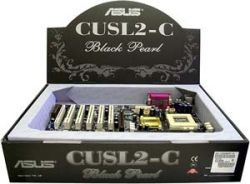 It is interesting that after folding the upper part of the box it becomes a ready support for a mainboard to be put to the storefront, which makes the box together with the board one of the most attractive things at the computer store. A silvery-gray cardboard box is laminated and has the words "Black Pearl" written diagonally. Board And ChipsetThe CUSL2-CB "Black Pearl" is implemented in the example of a popular CUSL2-C board. Now I'm going to tell you the chipset's specifications and describe the board briefly, which is necessary for those who don't remember the predecessor quite well. The i815EP chipset is a logical continuation of the previous set of chips from Intel - the i815E, differing from the today's one in the i752 based graphics core with low speed characteristics. Does it make sense to pay through the nose for a mainboard and save on a video adapter? It does for most business solutions, but for those who want to enjoy its performance in modern 3D applications it is insufficient. Anyway, lack of a graphics core doesn't tell upon the cost of this set of chips much, that is why a user won't care much about the presence or absence of this integrated video adapter cause it almost doesn't tell upon the price of the motherboard. This chipset features everything necessary for a modern PC: the north bridge of the chipset - the Intel 82815EP - supports Intel and VIA processors - the Pentium III, Celeron and Cyrix III with system bus frequencies 100 and 133 MHz, SDRAM is supported up to 512 MBytes, error correction (ECC) is absent, AGP 4x mode is supported. The only disadvantage is, in my opinion, a relatively low memory size support and lack of error correction - but Intel promotes other chipsets - with DRDRAM support - as a base for servers and efficient work stations. The south bridge of the chipset - the Intel 82801BA - has also got all necessary components: the support of high-speed protocols of data exchange with IDE-devices - ATA33/66/100, 4 USB ports, AC'97 sound support… I can go further and further in this enumeration but it is useless since you can easily find the information about this chipset yourself. I'd only add that the bridges are connected not with a PCI bus but with a new one which appeared due to a new Intel's architecture - Accelerated Hub Architecture. This bus allows a twice wider bandwidth - 266 Mbps instead of 133 Mbps and this allows to use all the capabilities of the chipset in full: ATA100 and others. Now when our short review of chipset specifications is over let's turn to the board itself and start with its specs: 
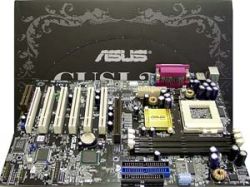 You can see that this board follows its predecessor (the CUSL2-C) in almost all respects. The most considerable difference between the two boards is the replacement of the ITE IT8703F chip (a controller of a keyboard, a mouse, serial and parallel ports) by the Winbond W83627GF, but I think that such change is connected not with any external factors but with the lack of chips in the storehouse of the company. In all other respects, the board has the same components: a proprietary system monitoring chip - the ASIC AS99127F, 11 LowESR capacitors (1500 uF), etc. Besides, the today's board lacks for a COM2 port as compared with the predecessor - it is replaced by a Smartconn - a connector for Smart-card reader, which is, in fact, a serial port. Setting the operation mode of the second serial port in the BIOS Setup we may choose a working mode of SmartCard Reader: either as an infrared port or as a usual serial port. There is a usual 9-pin connector of the COM-port on the rear panel of the board, and if the CUSL2-C doesn't allow to integrate a COM2 connector on the free space of the video adapter connector (the PCBs of the CUSL2-C and CUSL2 (the i815E based board) were the same), then the internal structure has changed. It is proved also by a lack of the space for an unsoldered second CNR connector. The board has got, similar to the predecessor, a block of DIP-switches for changing the FSB frequency, but they seem to be unnecessary because of the same function in the BIOS. There is also a switch for controlling the voltage supplied to the memory and the chipset; its default value is 3.3V which can be changed to 3.4 or 3.6V for overclocking. Besides, there is an AFPANEL connector for Asus iPanel. Now comes the most interesting part of the review - the BIOS. It is no secret that most settings are implemented in the BIOS. Asustek follows this tradition for quite a long time already - since the popular board P3B-F with its great deal of settings such as FSB frequencies, Vcore etc. Since then little has changed, in particular, the BIOS has shifted to Award Medallion v6.0. Today's board has also got the BIOS from Award, wide capabilities of memory timing configuration, a feature which allows to change the FSB frequency from 66 to 166 MHz in 1 MHz increments, and Vcore from the rated value to 2.1V in 0.05V steps, a capability of forced setting of correlation of FSB and memory bus frequencies: 66:100, 100:100, 133:100 and 133:133. All this stuff, plus changing the voltage supplied to the memory and chipset provide good overclocking potential. The same stuff could be seen on the CUSL2-C board. And since all the resources for fine adjustment of parameters are exhausted, the company decided to mark out this board with full-screen logos displayed in the course of booting - so called "Personalized Boot Logo". After simple manipulations with the BIOS file we can get any image on the screen during the booting. The BIOS file, as you know, consists of several parts and is, in fact, an archive file; one of these parts is an image that is displayed during the system booting. Using the Logo utility supplied on the CD, we can add images of BMP format at 640X480x16 into the BIOS file. The CD contains several ready images, and the other depends on your imagination. :) Now as for the benchmark results. PerformanceThe test system configuration:
Software:
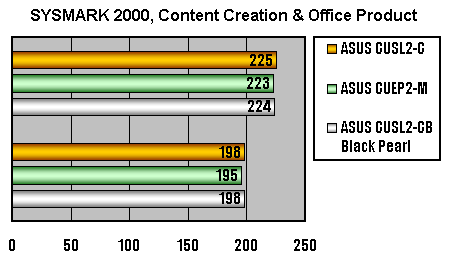 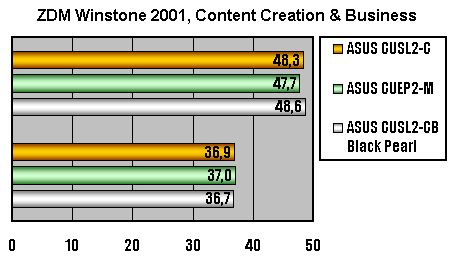 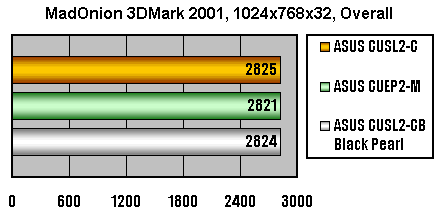  There are practically no differences between the two mainboards based on the same chipset from the same company, some deviations in the results can be caused by the inaccuracy of measurements which in most cases does not exceed 1% of the value. That is why, the test results of the CUSL2-C, shown on different sites, can be taken as the results of the CUSL2-CB. The comparison tests held by us and other testers show that the CUSL2-C is one of the most efficient boards based on the i815EP. This conclusion concerns the today's "pearl" as well, and since its complete set is one of the richest among the similar boards, I can strongly recommend it to all PC users, especially since the price is quite acceptable ($ 10-15 higher than that of the CUSL2-C). Frankly speaking, I feared to be disappointed
in the board both due to my respectful attitude to Asustek and due
to the fact that a black color became usual. But Asustek developers
have done their best - after benchmarking and the detailed analysis
of the complete set and designers' solutions I'm satisfied with
the CUSL2-CB. So, if you need a fast board for Intel's processors,
than go with this "pearl". Write a comment below. No registration needed!
|
Platform · Video · Multimedia · Mobile · Other || About us & Privacy policy · Twitter · Facebook Copyright © Byrds Research & Publishing, Ltd., 1997–2011. All rights reserved. |